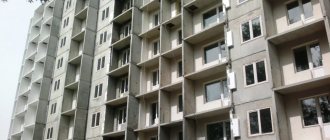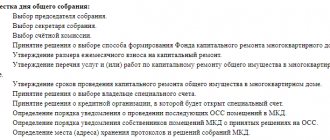Definition of the concept of “capital construction object”
The legislation of the Russian Federation does not establish a clear list of objects that belong to capital construction projects.
A capital construction project is an object (or a set of objects) erected for the purpose of long-term operation and forming a single architectural, urban planning, volumetric-spatial, functional, engineering, technical and technological whole with the land plot.
Capital construction projects are buildings, structures, structures, objects whose construction has not been completed, with the exception of non-capital buildings, structures and inseparable improvements to a land plot (paving, covering, etc.) (Clause 10, Article 1 of the Town Planning Code of the Russian Federation). Thus, this rule of law, defining the generic concept of “capital construction object,” on the one hand, names four types of objects that are classified as such:
building; buildings; structures; unfinished construction projects;
and on the other hand, it lists objects that are not such:
temporary buildings; kiosks; awnings; other similar buildings.
The legal characteristics of these capital construction projects are given in other regulatory legal acts, in particular, in the Federal Law of December 30, 2009 N 384-FZ “Technical Regulations on the Safety of Buildings and Structures” (hereinafter referred to as the Technical Regulations).
Capital construction projects can only be created during the construction process (clauses 10, 13, Article 1 of the Civil Code of the Russian Federation), which involves the phased implementation of design, installation, and commissioning work.
If it is planned to construct a capital construction project related to real estate, it is necessary to obtain a construction permit and a commissioning permit. After which the object can be registered in the cadastral register, as well as the ownership of it can be registered in the Unified State Register of Real Estate.
For the relationship between the concepts of “real estate” and “capital construction object”, see below.
The main features of capital construction projects include the following:
- a strong connection of the object with the ground and the presence of a buried foundation (however, a non-permanent object can also have a foundation);
- the impossibility of moving an object without causing disproportionate damage to its purpose.
Additional features of capital construction projects include:
- availability of stationary communications (water, gas, electricity and heat supplies, etc.);
- long service life of the facility.
The legislative framework
In 2004, after revision, the Town Planning Code of the Russian Federation came into force. More details about construction issues can be found in Article 52 of the Code. It also examines cases of reconstruction. Issues of capital construction are highlighted separately. They are also covered by federal laws. Authorities are developing regulations of the Russian Federation in this area.
All types of capital construction work are carried out by entrepreneurs or construction companies well-known in this field. It is possible for a legal entity to carry out the work plan, provided that it belongs to a self-regulatory organization in the area in question. All responsibility for laying the foundation and erecting the building lies with the chief engineers of the projects. If a certain type of action is carried out, which is specified in the agreement of the parties, then the second party becomes persons who are not members of the self-regulatory organization. The second part of the Federal Law states that citizens have the right to participate in a construction contract concluded with the customer. It is also possible to conclude an agreement with the developer. A construction permit is issued if each contract is concluded for no more than 3 million rubles.
State-owned enterprises do not have to be members of self-regulatory organizations.
This law also states that construction work can be carried out by a developer who complies with all the norms of project documentation. It provides safety precautions at a construction site. Compliance with all technical regulations is an important part of the process. The construction manager is responsible for the quality of work.
The chief at the construction site, if he is not a member of a self-regulatory company, has the right to invite employees to work on the basis of a construction contract. He enters into an agreement with them, which specifies the work plan and time frame for completing the order. If a company receives only work on certain areas or types of construction, then it is necessary to enter into an agreement with the customer. This paper describes all the necessary steps. Then possible costs are calculated.
The customer’s responsibilities include preparing the area where the building will be erected. Afterwards, he transfers to the contractor a construction permit and the drawings and papers necessary for the work. The next step will be the transfer of materials. The design documentation remains with the contractor during construction. It happens that there is a change of contractors or it is necessary to urgently stop construction. Then it is necessary to mothball such capital construction projects; such a decision would be a last resort. It is usually accepted when work has not been performed for more than 6 months in a row and functional impairment is evident.
When construction of a capital construction project begins, construction supervision is possible. This body must be notified of the start of activities 7 days before the start of construction. The control team needs to check all relevant documents.
The relationship between the concepts of “real estate” and “capital construction object”
In accordance with Art. 130 of the Civil Code of the Russian Federation, immovable things (real estate, real estate) include land plots, subsoil plots and everything that is firmly connected to the land, that is, objects whose movement without disproportionate damage to their purpose is impossible, including buildings, structures, unfinished construction objects .
The concept of “real estate object” is not identical to the concept of “capital construction object”. A real estate property may not be a capital construction project, just as a capital project is not always real estate.
For example, a residential house or building are real estate objects and capital construction objects in accordance with clause 10 of Art. 1 Civil Code of the Russian Federation, part 1 art. 130 of the Civil Code of the Russian Federation (created as a result of construction, there is a strong connection with the land and an independent functional purpose).
The land plot is classified as real estate by virtue of the direct instructions of Art. 130 of the Civil Code of the Russian Federation, but is not an object of capital construction since it is not the result of construction.
A building for auxiliary use may have all the characteristics of a capital construction project (the result of construction, a strong connection with the ground and the impossibility of moving the object without disproportionate damage), at the same time such an object will not be classified as real estate, since there is no “independent functional purpose of the object”, respectively , there are no qualities of an independent real estate object.
On the issue of the identity of the concepts “capital construction object” and “real estate object”, the position of the Supreme Arbitration Court of the Russian Federation, expressed in Resolution of the Presidium of the Supreme Arbitration Court of the Russian Federation of September 24, 2013 N 1160/13 in case N A76-1598/2012, remains relevant, which states the following.
The term “capital construction object” is a special concept of urban planning legislation, therefore it cannot replace the legal category “real estate object”, which has a different industry, volume and content.
This conclusion was made in relation to the registration of ownership of the fence on the foundation. The court indicated that due to the lack of qualities of an independent real estate object in the fence, ownership of it is not subject to registration, regardless of its physical characteristics and the presence of individual elements that ensure a strong connection of this structure with the corresponding land plot. The fence does not have an independent economic purpose and is not a separate object of civil circulation.
Unfinished construction projects
The term “structures” is applicable mainly to auxiliary buildings that are part of the main building complex. These include buildings for economic and service purposes. The main difference from OKS is that they are not registered in the state register, as a separate accounting element, and are not assigned a separate cadastral number. The concept of “unfinished object” refers to OKS. The difference is that they are built in stages, at time intervals. The main reason for the “freezing” is the lack or gradual development of financial resources.
Attention! First, the intended purpose of the land plot for development is determined and property rights are registered. A complete package of documents is prepared for the start of construction. The unfinished object is entered into the state register and assigned a cadastral number. After construction is completed, it is put into operation. Such a building is a capital construction.
Building
A building is one of the types of real estate and capital construction projects (clause 1 of article 130 of the Civil Code of the Russian Federation, clause 10 of article 1 of the Civil Code of the Russian Federation).
A building is a result of construction, which is a volumetric construction system having above-ground and (or) underground parts, including premises, engineering support networks and engineering support systems and intended for living and (or) activities of people, location of production, storage of products or keeping animals (clause 6 of part 2 of article 2 of the Technical Regulations). The three main elements (subsystems) of the building are described in the same article of the Technical Regulations:
- a room is a part of the volume of a building or structure that has a specific purpose and is limited by building structures (clause 14, part 2, article 2 of the Technical Regulations);
- engineering and technical support network - a set of pipelines, communications and other structures intended for engineering and technical support of buildings and structures (clause 20, part 2, article 2 of the Technical Regulations);
- The engineering and technical support system is designed to perform the functions of water supply, sewerage, heating, ventilation, air conditioning, gas supply, electricity supply, communications, information, dispatch, waste disposal, vertical transport (elevators, escalators) or security functions. (clause 21, part 2, article 2 of the Technical Regulations).
Buildings can be classified on the following basis:
- Depending on the purpose, buildings are divided into: residential and non-residential buildings;
- depending on the types of multi-apartment buildings, there are: multi-apartment buildings of the gallery type, multi-apartment buildings of the corridor type and multi-apartment buildings of the sectional type;
- depending on the classification of residential buildings into the housing stock, the following are distinguished: residential buildings included in the housing stock, residential buildings (premises) not included in the housing stock, departmental housing;
- depending on the significance (dominant or secondary), buildings on a land plot are divided into: main (dominant in terms of capital construction, architectural features and their purpose) and service (have secondary importance in relation to the main building on the land plot);
- By type of operating modes, taking into account their functional purpose, the following buildings are distinguished: intended for permanent or long-term (24-hour) residence of people; intended for temporary stay of people, mainly of a rhythmic nature (working day, school shift, session, etc.); industrial or warehouse buildings.
Difference between buildings and structures
These concepts are often used interchangeably, but buildings include structures that have an above-ground part and separate rooms. They are used for living, studying, manufacturing, sports, etc.
A structure, according to the Town Planning Code, is any object erected by a person (stadium, bunker, column, etc.). Structures may be deprived of an above-ground part. According to the practice that has developed over time, construction is a broader concept.
Let's summarize how a building differs from a structure:
- Special purpose. The buildings are adapted for people to live, work and study. Structures perform technical functions. Buildings always have architectural completeness.
- Structures can be placed underground, but buildings always have an above-ground part.
Structure
definition of the concept “ structure ” in the Technical Regulations. There is only a definition of “building structure”, considered as a part of a building or structure that performs certain load-bearing, enclosing and (or) aesthetic functions.
A structure is a generic legal category denoting a set of capital architectural and construction projects, including buildings, structures, unfinished construction projects and their varieties. In this sense, the building can be considered synonymous with the concept of “capital construction object”.
It should be taken into account that buildings can be of either capital or non-capital type (clauses 10, 10.2 of article 1 of the Civil Code of the Russian Federation). In the Civil Code of the Russian Federation, buildings are not named as real estate objects. For the purpose of accounting for the housing stock in the Russian Federation, buildings are considered to be separately constructed buildings, houses consisting of one or several parts as one whole, as well as service buildings (Appendix 1 to the Instructions approved by Order of the Ministry of Land Construction of Russia dated 08/04/1998 N 37).
A capital construction project can be registered in the cadastral register only as a building, structure or an unfinished construction project (Clause 1, Part 4, Article 8 of the Law on State Registration of Real Estate). Cadastral registration of buildings is not provided for by law.
How are they different from a non-permanent building?
A number of buildings do not have signs of a permanent structure. These buildings are called temporary.
Comparing a permanent structure and a temporary building, the following differences can be identified:
- A capital building, unlike a temporary one, is located on a foundation and is firmly tied to the ground.
- For the construction of an OKS it is necessary to collect an extensive list of necessary documents, while for the construction of a temporary building no documentation is required.
- A capital asset can be in operation from 25 to 100 years, but temporarily cannot be used for more than 5 years.
- A permanent structure cannot be dismantled and transported to another location, while temporary construction involves dismantling and moving to any distance.
- You can obtain ownership documents for a capital construction, while such documentation cannot be obtained for a temporary structure.
Construction
A structure (with the exception of non-capital) is one of the types of real estate and capital construction projects (clause 1 of article 130 of the Civil Code of the Russian Federation, clause 10 of article 1 of the Civil Code of the Russian Federation).
A structure is a result of construction, which is a volumetric, planar or linear building system, having ground, above-ground and (or) underground parts, consisting of load-bearing, and in some cases, enclosing building structures and intended for performing various types of production processes, storing products, temporary stay of people, movement of people and goods; (clause 23 of part 2 of article 2 of the Technical Regulations).
An object acting as a structure is any separate structure with all devices that form one whole with it.
The structure may also be non-permanent , i.e. not have a strong connection with the earth. The structural characteristics of non-permanent structures allow them to be moved and (or) dismantled, subsequently assembled without disproportionate damage to the purpose and without changing the main characteristics of structures, including kiosks, canopies and other similar structures (Clause 10.2 of Article 1 of the Civil Code of the Russian Federation).
Such structures should not be recognized as real estate due to the absence of all the signs of real estate specified in paragraph 1 of Art. 130 Civil Code of the Russian Federation.
When constructing non-permanent structures , there is no need to obtain a construction permit, for commissioning, and also to register them in the cadastral register and register the rights to them in the Unified State Register of Real Estate (Clause 2, Part 17, Article 51, Part 1, Article 55 of the Civil Code of the Russian Federation, Part 6, 7 Article 1 of the Law on State Registration of Real Estate).
Classification of electric grid facilities as non-permanent structures
The construction of any building or structure (including power grid facilities) is carried out according to a pre-developed document - design documentation. The list of activities for technological connection is determined in the technical conditions, which are an integral part of the agreement and the obligations of the parties to implement them are essential terms of the technological connection agreement. Responsibilities for the implementation of technical specifications are distributed as follows:
- In relation to applicants - legal entities with a maximum power of up to 150 kW (specified in clause 12.1 of the Technological Connection Rules) and individuals with a maximum power of up to 15 kW (specified in clause 14 of the Rules), the parties are required to carry out measures up to the point of connection, which is determined no later than 15 meters outward from the border of the applicant’s property;
- In relation to the remaining applicants, activities within the boundaries of the site on which the applicant’s facilities are located are carried out by the applicant, and activities up to the border of the applicant’s site are carried out by the network organization.
Before starting the construction of power grid facilities, the network organization needs to develop design documentation. The legal nature of architectural and construction design is revealed in Part 1 of Article 48 “Town Planning Code of the Russian Federation” (GrK RF). Thus, architectural and construction design involves the preparation of design documentation in relation to capital construction projects under construction and reconstruction and their parts, and also involves the preparation of individual sections of design documentation when carrying out major repairs of these facilities. As we see, design documentation is developed in relation to objects that must simultaneously meet the following conditions:
- Firstly, the object of design documentation is capital construction objects or parts of a capital construction object;
- Secondly, design documentation is prepared for capital construction projects under construction and reconstruction.
In addition, certain sections of design documentation are developed during major repairs of capital construction projects. Thus, the development of design documentation is possible not only for the capital construction project as a whole, but also for part of the capital construction project during its construction, reconstruction, and major repairs. Since 04.08.2018, the Civil Code of the Russian Federation has been supplemented with the concept of “non-permanent structure and construction”. In connection with the introduction of these changes, part 1 of Article 48 of the Civil Code of the Russian Federation is subject to clarification in terms of the mandatory preparation of design documentation not only for capital facilities, but also for non-capital buildings and structures that are not capital construction projects. To disclose the content of the objects of the design documentation in terms of technological connection, let us turn to the conceptual apparatus defined by Article 1 of the Civil Code of the Russian Federation:
- capital construction facility - a building, structure, structure, objects whose construction has not been completed (hereinafter referred to as unfinished construction objects), with the exception of non-capital buildings, structures and inseparable improvements to the land plot (paving, covering and others);
- non-permanent buildings, structures - buildings, structures that do not have a strong connection with the ground and whose design characteristics allow for their movement and (or) dismantling and subsequent assembly without disproportionate damage to the purpose and without changing the main characteristics of buildings, structures (including kiosks, canopies and other similar buildings, structures);
- linear objects - power lines, communication lines (including linear cable structures), pipelines, highways, railway lines and other similar structures;
- construction - creation of buildings, structures, structures (including on the site of demolished capital construction projects);
- reconstruction of linear objects - a change in the parameters of linear objects or their sections (parts), which entails a change in the class, category and (or) initially established indicators of the functioning of such objects (power, carrying capacity, etc.) or which requires a change in the boundaries of right of way and ( or) security zones of such objects.
From the concept of “linear object” it follows that objects related to this concept are structures. A structure is understood as a result of construction, which is a volumetric, planar or linear building system, having ground, above-ground and (or) underground parts, consisting of load-bearing, and in some cases, enclosing building structures and intended for performing various types of production processes, storing products , temporary stay of people, movement of people and goods[1]. From the analysis of the above provisions of the legislation, it follows that power grid facilities, the construction or reconstruction of which is carried out within the framework of a technological connection agreement, are structures, relate to linear facilities and can be both capital construction projects and non-capital structures. The criteria for a non-permanent structure are two simultaneous conditions:
- the object does not have a strong connection with the earth;
- the structural characteristics of the object allow its movement and (or) dismantling and subsequent assembly without disproportionate damage to the purpose and without changing the main characteristics.
Taking into account these criteria, it can be noted that linear objects (overhead, cable power lines, block and complete transformer substations) can be non-permanent structures , since their design characteristics allow their movement and (or) dismantling and subsequent assembly without disproportionate damage to the purpose and without changing the main characteristics. This position is confirmed in judicial practice (2). As for brick transformer substations, they are objects of capital construction, since they do not meet the criteria for a non-capital structure (structure). It is necessary to point out that distribution points and transformer substations belong to linear objects, since they are an integral part of the transport infrastructure that ensures the transmission of electricity through power lines. This thesis is confirmed by numerous judicial practices (3). The classification of linear facilities by network organizations as capital or non-capital structures is of particular importance in practice. Thus, part 3 of Article 49 of the Civil Code of the Russian Federation establishes that the examination of project documentation is not carried out if a construction permit is not required for the construction or reconstruction of a capital construction project. For example, Decree of the Administration of the Volgograd Region dated August 27, 2021 N 373-p[2] allows the construction and reconstruction of electrical grid facilities with a voltage level not exceeding 35 kV. The Law of the Chuvash Republic dated June 4, 2007 No. 11 “On the regulation of urban planning activities in the Chuvash Republic” also allows for the construction and reconstruction of electrical grid facilities with a voltage class of up to 35 kV without obtaining permission. In addition, from 08/04/2018, part 17 of article 51 of the Civil Code of the Russian Federation was supplemented with clause 2, according to which a construction permit is also not required for objects that are not capital construction projects. In other words, if a network organization classifies its constructed power grid facilities as non-permanent structures (with the exception of brick substations and distribution points), then it does not need to conduct an examination and obtain a construction permit.
Links to materials:
- subp. 23 clause 2 art. 2 of the Federal Law of December 30, 2009 N 384-FZ “Technical Regulations on the Safety of Buildings and Structures”
- Resolution of the Moscow District Court of Justice dated November 29, 2021 in case No. A41-33132/2019, resolution of the Moscow District Court of Justice dated October 23, 2021 in case No. A41-103970/2017.
- Resolution of the Fourteenth Arbitration Court of Appeal dated January 27, 2015 N 14AP-10528/14, Resolution of the Volga District Arbitration Court dated June 14, 2021 in case No. A55-11700/2017, Resolution of the Volga District Arbitration Court dated July 1, 2021 in case N A72-9330/2018, upheld by the ruling of the RF Armed Forces dated September 10, 2021 N 306-ES19-15197.
- Resolution of the Administration of the Volgograd Region dated August 27, 2018 N 373-p “On establishing cases other than those specified in the Town Planning Code of the Russian Federation in which obtaining a building permit on the territory of the Volgograd Region is not required”
Unfinished construction project
The Town Planning Code of the Russian Federation and the Technical Regulations do not contain a definition of the concept “object of unfinished construction”. This definition is contained in the Methodological Recommendations for Accounting of Investments Made in the Form of Capital Investments in Agricultural Organizations, approved. Ministry of Agriculture of the Russian Federation October 22, 2008:
objects under construction include objects: the construction of which is ongoing; the construction of which is suspended, mothballed or completely terminated, but not written off in the prescribed manner; in operation, for which acceptance certificates have not yet been issued in the prescribed manner.
To understand whether any object is an unfinished construction project, one must take into account the legal position of the Supreme Court of the Russian Federation:
“When resolving the issue of recognizing an object legally under construction as an immovable thing (an object of unfinished construction), it is necessary to establish that at least the foundation construction work or similar work has been completed on it (clause 1 of Article 130 of the Civil Code of the Russian Federation). Paving of a land plot that does not meet the characteristics of a structure is part of it and cannot be recognized as an independent immovable thing (clause 1 of Article 133 of the Civil Code of the Russian Federation).” (Clause 38 of the Resolution of the Plenum of the Armed Forces of the Russian Federation of June 23, 2015 N 25 “On the application by courts of certain provisions of Section I of Part One of the Civil Code of the Russian Federation”).
All these objects can be divided into the following types:
- residential buildings - buildings equipped with the necessary communication systems and consisting of two parts: above-ground and underground, intended for human habitation or production facilities;
- non-residential premises - premises for temporary stay of people: stadiums, bridges, power lines, etc.;
- objects of unfinished construction - buildings the construction of which has been suspended for a certain period.
All these objects are divided into many subgroups and classified according to key characteristics.
Linear objects
As a general rule, linear objects are real estate, since they are a type of structure and, accordingly, a subtype of capital construction projects.
In clause 10.1 of Art. 1 of the Civil Code of the Russian Federation defines the concept of “linear objects” by listing the main types of such objects - these are power lines, communication lines (including linear cable structures), pipelines, highways, railway lines and other similar structures.
Linear objects must be firmly connected to the ground, and their movement is impossible without disproportionate damage to their purpose (clause 1 of article 130 of the Civil Code of the Russian Federation, clause 10.1 of article 1 of the Civil Code of the Russian Federation). In other cases, linear structures will not be classified as real estate. So, for example, communication lines can be both real estate (linear cable structures) and movable property - transmission lines, physical circuits.
Thus, if a linear object meets the characteristics of a structure, then the provisions of the Civil Code of the Russian Federation on linear objects apply to it.
If a linear object does not meet the characteristics of a structure, then the norms of the Civil Code of the Russian Federation on linear objects do not apply to it, but at the same time, the provisions of other laws that regulate relations related to linear objects that are not capital construction objects (land, environmental and etc.).
Capital buildings
The construction of capital-type structures involves the performance of certain works.
These include:
- exploration;
- design;
- assembly
Definition
Capital construction involves the construction/reconstruction of facilities that require not only construction, but also earthworks.
Capital construction projects (CCFs) can be buildings, structures and other objects for which construction work has not been completed.
Clause 1, Article 10 of the Civil Code of the Russian Federation
Signs
The main distinguishing feature of such a structure is the presence of a foundation. On this basis, we present the following feature - the presence of design documentation and a permit certificate, which is issued on the basis of the requirements of the Town Planning Code of the Russian Federation.
It is necessary to have a list of necessary documents confirming the right to use or dispose of property. Otherwise, the building is considered unauthorized.
Kinds
A capital structure, as defined by the Town Planning Code, sounds like a separate structure, equipped with all communications and ancillary structures.
Existing types:
- A residential building, equipped with all the necessary communication systems and consisting of both above-ground and underground parts. The purpose of building such a premises is to accommodate people, accommodate production, and keep animals.
- Non-residential premises - intended for temporary stay.
Classification
The Cadastral Code sets out the definition and types of CS objects.
Let's consider the division of objects by the code into the following categories:
- buildings and structures, including those that serve as communications facilities;
- unfinished objects.
Decree of the Government of the Russian Federation No. 87 gives its classification.
Depending on the functionality, they differ:
- construction of linear objects, the construction of which involves design and land surveying;
- production and industrial facilities;
- security-providing defensive structures;
- buildings for domestic, social and cultural purposes.
Non-permanent buildings. Temporary buildings
A non-capital object does not have a strong connection with the land, and it may be intended for temporary use.
Non-permanent buildings do not belong to capital construction projects and real estate.
Non-permanent buildings, structures - buildings, structures that do not have a strong connection with the ground and whose design characteristics allow for their movement and (or) dismantling and subsequent assembly without disproportionate damage to the purpose and without changing the main characteristics of buildings, structures (including kiosks, canopies and other similar buildings, structures) (clause 10.2 of article 1 of the Civil Code of the Russian Federation).
Thus, a distinctive feature of non-capital objects is the possibility of free movement of objects without causing disproportionate damage to their purpose, including the possibility of their dismantling (demolition) with disassembly into their constituent prefabricated movable structural elements.
Another distinguishing feature of a non-capital object from a capital one is its temporary nature, namely the fact of construction of the object for a certain period of time
Temporary building is an object erected for the purpose of short-term operation, auxiliary use and does not have complex design features.
Temporary buildings include:
- kiosks and canopies;
- some landscaping facilities, including pavilions, elements of equipment for public passenger transport stops, mechanized car parks, telephone booths, etc.;
- any buildings that are intended to serve the main facility or are of an auxiliary nature (sheds, bathhouses, greenhouses, hotbeds, etc.);
- easily erected structures, lightweight prefabricated structures;
- buildings erected in the forest (dryers, mushroom farms, warehouses).
Objects that cannot be classified as capital construction
The OKS does not include objects the construction of which does not require special permits - these are temporary buildings and non-stationary structures. The first type includes objects whose placement is intended to provide proper conditions for construction work. Such objects may be places for storing equipment or short-term residence of people. Such buildings are dismantled after completion of the main work. The existence of temporary buildings in most cases is not allowed for more than five years.
The second type includes mobile structures that are easily assembled and disassembled for transportation to another location. These can be pavilions, kiosks, boxes, canopies, and consumer service outlets. For the construction of such buildings, lightweight materials and structures are used.
Thus, the key characteristics of non-capital objects are their temporary nature and the ability to move them without causing significant damage.
If these indicators are not obvious, the determination of capital or non-capitality of an object is carried out on the basis of an expert opinion.
Classification of capital construction projects
According to the level of significance, capital construction projects are divided into (clauses 18 - 20, Article 1 of the Civil Code of the Russian Federation):
- objects of federal significance (i.e. capital construction objects, other objects, territories that are necessary for the exercise of powers on issues within the jurisdiction of the Russian Federation);
- objects of regional significance (i.e. capital construction objects, other objects, territories that are necessary for the exercise of powers on issues falling under the jurisdiction of a constituent entity of the Russian Federation);
- objects of local significance (i.e. capital construction projects, other objects, territories that are necessary for local government bodies to exercise powers on issues of local significance and within the limits of transferred state powers in accordance with federal laws, the law of a constituent entity of the Russian Federation, the charters of municipalities and provide significant impact on the socio-economic development of municipal areas, settlements, urban districts).
Depending on the functional purpose and characteristic features, capital construction projects are divided into the following types (paragraph “a” - “c”, paragraph 2 of the Regulations on the composition of sections of project documentation and requirements for their content, approved by Decree of the Government of the Russian Federation of February 16, 2008 N 87):
- facilities for industrial purposes (buildings, structures, structures for industrial purposes, including defense and security facilities), with the exception of linear facilities;
- non-production facilities (buildings, structures, housing structures, social, cultural and public utility purposes, as well as other capital construction facilities for non-production purposes);
- linear objects (pipelines, roads and railways, power lines, etc.).
particularly dangerous, technically complex and unique capital construction projects can be identified separately (Article 48.1 of the Civil Code of the Russian Federation).
What is the difference between OKS and temporary structures?
All building structures of the OKS category are tied to certain areas, according to their intended purpose, with specific coordinates, placement plan, and boundaries. The main legal act regulating them is the Federal Law of the Russian Federation “On the State Real Estate Cadastre” (No. 93, 2007). Only one object - road construction - is based on the law “On Highways and Road Activities”.
Signs of a capital construction project:
- attached to a specific land plot;
- most of the buildings with ruined foundations;
- it is impossible to disassemble or dismantle without damaging functional components or material damage;
- high assessed value;
- A complete package of legal documents is registered for the building.
Healthy! There are OKS of federal, regional, and municipal significance.







